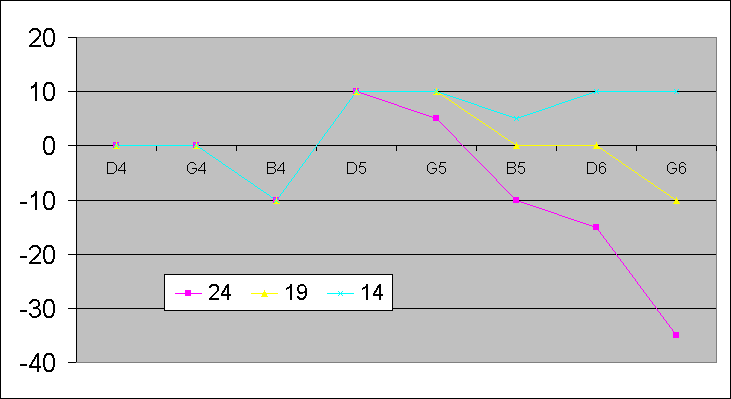IntroductionThe question often arises - how should I set the stopper on my flute? (The stopper is that obstruction in the bore of the flute, just beyond the embouchure hole. It often takes the form of a cork, with or without a screw connection to the cap or crown. ) There is a classic answer - the stopper should be set one bore diameter back from the middle of the embouchure. In a Boehm flute, this means 17mm. In a 19th century conical flute or a copy thereof, it means 19mm (3/4"). The cleaning stick that comes with your flute probably already has a mark on it, the required distance from the end (if not, pencil it in!). Introduce the stick backwards up the head of the flute until it rests against the stopper. The mark should now appear in the middle of the embouchure hole. But can you be sure? Suppose your flute doesn't for some reason obey the
rules? Can we determine the correct position from first principles? I set out to
find out. MethodologyThe flute under test is an original Boosey & Co R.S.Prattens Perfected - a popular 8-key design of the late 19th century. I set the stopper firstly to the nominal position (19mm from centre) and then 5mm (3/16") each side of nominal and compared the tuning. I chose D,G and B and their octaves to give an uncluttered picture. Note that D4 is the low D of the flute.
ConclusionsWe can draw these conclusions:
But, Hang On ....All this talk of the third octave might leave you cold if you never venture up there (Irish music for example rarely ventures past B5 - the B in the second octave). But it remains important. A flute works at its best when all the harmonics are lined up accurately and pulling together. So, even if you will never play a G6, having it in tune will assist the focus on the lower G notes. Because the line up of harmonics is important, I chose to avoid tricky fingerings which might improve the third octave notes "unnaturally". So all the D notes were played using xxx xxx, and all the G notes using xxx ooo. Because sounding G6 is hard this way, I started with xox ooo, then shifted back to xxx ooo once I had the note established. Setting the StopperFrom the above, it suggests:
Alarm BellsIf you find that the tuning of your flute is so awry that you cannot determine a fairly clear ideal stopper position, it possibly indicates a problem with the instrument itself. Don't persevere with an instrument with dodgy intonation or poor response - the pain and struggle exceeds the rewards. Have it checked out by more experienced player or compare it with any other flutes you have access to. If still in doubt, bring it to the attention of a good flute-maker for comment. If you have no other recourse, write out a map of the errors and send it to me for comment.
Back to McGee Flutes home page...
|
